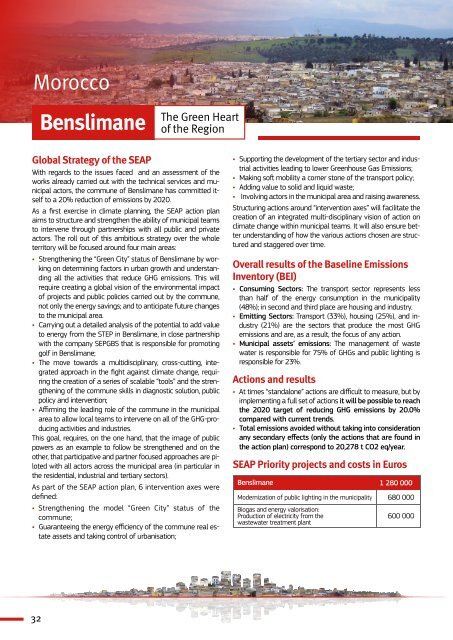CES-MED Publication EN-final 2018-WEB
Create successful ePaper yourself
Turn your PDF publications into a flip-book with our unique Google optimized e-Paper software.
Morocco<br />
Benslimane<br />
The Green Heart<br />
of the Region<br />
Global Strategy of the SEAP<br />
With regards to the issues faced and an assessment of the<br />
works already carried out with the technical services and municipal<br />
actors, the commune of Benslimane has committed itself<br />
to a 20% reduction of emissions by 2020.<br />
As a first exercise in climate planning, the SEAP action plan<br />
aims to structure and strengthen the ability of municipal teams<br />
to intervene through partnerships with all public and private<br />
actors. The roll out of this ambitious strategy over the whole<br />
territory will be focused around four main areas:<br />
• Strengthening the “Green City” status of Benslimane by working<br />
on determining factors in urban growth and understanding<br />
all the activities that reduce GHG emissions. This will<br />
require creating a global vision of the environmental impact<br />
of projects and public policies carried out by the commune,<br />
not only the energy savings; and to anticipate future changes<br />
to the municipal area.<br />
• Carrying out a detailed analysis of the potential to add value<br />
to energy from the STEP in Benslimane, in close partnership<br />
with the company SEPGBS that is responsible for promoting<br />
golf in Benslimane;<br />
• The move towards a multidisciplinary, cross-cutting, integrated<br />
approach in the fight against climate change, requiring<br />
the creation of a series of scalable “tools” and the strengthening<br />
of the commune skills in diagnostic solution, public<br />
policy and intervention;<br />
• Affirming the leading role of the commune in the municipal<br />
area to allow local teams to intervene on all of the GHG-producing<br />
activities and industries.<br />
This goal, requires, on the one hand, that the image of public<br />
powers as an example to follow be strengthened and on the<br />
other, that participative and partner focused approaches are piloted<br />
with all actors across the municipal area (in particular in<br />
the residential, industrial and tertiary sectors).<br />
As part of the SEAP action plan, 6 intervention axes were<br />
defined:<br />
• Strengthening the model “Green City” status of the<br />
commune;<br />
• Guaranteeing the energy efficiency of the commune real estate<br />
assets and taking control of urbanisation;<br />
• Supporting the development of the tertiary sector and industrial<br />
activities leading to lower Greenhouse Gas Emissions;<br />
• Making soft mobility a corner stone of the transport policy;<br />
• Adding value to solid and liquid waste;<br />
• Involving actors in the municipal area and raising awareness.<br />
Structuring actions around “intervention axes” will facilitate the<br />
creation of an integrated multi-disciplinary vision of action on<br />
climate change within municipal teams. It will also ensure better<br />
understanding of how the various actions chosen are structured<br />
and staggered over time.<br />
Overall results of the Baseline Emissions<br />
Inventory (BEI)<br />
• Consuming Sectors: The transport sector represents less<br />
than half of the energy consumption in the municipality<br />
(48%); in second and third place are housing and industry.<br />
• Emitting Sectors: Transport (33%), housing (25%), and industry<br />
(21%) are the sectors that produce the most GHG<br />
emissions and are, as a result, the focus of any action.<br />
• Municipal assets’ emissions: The management of waste<br />
water is responsible for 75% of GHGs and public lighting is<br />
responsible for 23%.<br />
Actions and results<br />
• At times “standalone” actions are difficult to measure, but by<br />
implementing a full set of actions it will be possible to reach<br />
the 2020 target of reducing GHG emissions by 20.0%<br />
compared with current trends.<br />
• Total emissions avoided without taking into consideration<br />
any secondary effects (only the actions that are found in<br />
the action plan) correspond to 20,278 t CO2 eq/year.<br />
SEAP Priority projects and costs in Euros<br />
32
















